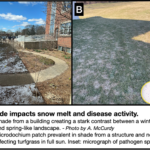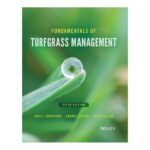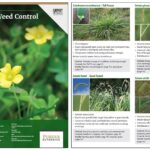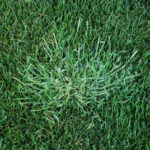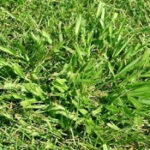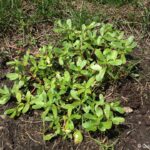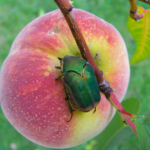Turf Tips Archives
A Cold Mold that Craves the Shade
Pink snow mold is a disease caused by the fungal pathogen Microdochium nivale (syn. Monographella nivalis) that is being observed in middle and northern Indiana this late winter. The pathogen is termed psychrophilic, or cold loving, due to its propensity to grow and infect in colder temperatures. The disease can be particularly severe on unfrozen […]
Look Below Before Blaming Above
Recently, home lawns have been maligned in several media outlets as a waste of time and resources. Mismanagement by using too much water or misplacing fertilizer may compound the issue by straining environmental resources or serving as pollutants. While not going into all the defenses for turfgrass use on home lawns, (remember “right plant, right […]
Virtual field days present challenges and benefits
COVID-19 guarantees that the Summer of 2020 will be like none we have experienced. We will be exploring what that means in Indiana by telling the stories of Purdue Agriculture’s and Purdue Extension’s interactions with communities throughout the state. We invite you to follow our series on this Season of Change. Read the full article […]
Green Industry Businesses Share Protocols to Maximize the Health and Safety During the Covid-19 Pandemic
By Kyle Daniel, Lindsey Purcell, Cliff Sadof, Aaron Patton, Janna Beckerman, Tom Creswell, John Bonkowski, Rosie Lerner Day-to-day activities have changed every aspect of businesses throughout the country. The Green Industry is no exception, with changes implemented to maintain safe working environments for employees and their clients while being compliant with the state’s Executive Order. […]
Rounds 4 Research: Auction is Open until May 6. Support the Purdue Turf Program
The 2018 Rounds 4 Research auction is now open. The auction is open April 30-May 6, 2018 with proceeds going to support turf research at Purdue University and in Indiana through the Midwest Regional Turf Foundation. Fundraising supports research and education programs for the benefit of golf course management professionals, golf facilities, and the game. […]
Two Purdue Authors Revise Turfgrass Textbook
Fundamentals of Turfgrass Management is the bestselling text with expert coverage of basic turfgrass science and all aspects of practical care. Now in its fifth edition, this industry favorite offers the latest information on growth, nutrition, herbicides, insecticides, and fungicides, as well as new chapters discussing shade stress and light requirements and the benefits of turf. […]
2017 Turf Weed Control for Professionals, Now Available
Now available, the revised edition of Turfgrass Weed Control for Professionals. This sixth edition, released in February 2017, includes major modifications including: Eleven states (IA, IL, KS, KY, MI, MN, MO, NE, NY, OH, WI) were added as well as their experts as collaborators to transform this to a multi-state publication. The identification of 105 weeds […]
Rounds 4 Research: Auction is Open until May 7. Support the Purdue Turf Program
The 2017 Rounds 4 Research auction is now open. The auction is open May 1-7, 2017 with proceeds going to support turf research at Purdue University and in Indiana through the Midwest Regional Turf Foundation. Fundraising supports research and education programs for the benefit of golf course management professionals, golf facilities, and the game. This […]
Purdue Launches Turf Diagnostic Mobile App
The Purdue Turf Doctor app, a collaborative effort among Drs. Doug Richmond, Aaron Patton and Rick Latin, is the latest modern turfgrass management tool produced by the Purdue Turfgrass Science team. The app is designed to help homeowners and land managers diagnose and address turfgrass problems caused by a variety of factors including weeds, insects, […]
Crabgrass is out in full force in 2016!
Why is crabgrass so bad this year? Several factors contribute to a bad year for crabgrass. Crabgrass is a warm-season grass meaning that it thrives in hot conditions with optimum growth in temperatures ranging from 88 to 95 °F. However, our primary lawn species in Indiana are cool-season grasses and they prefer cooler conditions and […]
Turf and Landscape Field Day on July 12, 2016
On Tuesday, July 12, 2016 the Purdue Turf Program and the Midwest Regional Turf Foundation will host the Turf and Landscape Field Day. The Turf and Landscape Field Day is Indiana’s largest green industry field day. This will be the third year with landscape research tours added. Specialists from four different departments in the College […]
Field Paspalum
Field Paspalum Biology: Field paspalum (Paspalum laeve Michx.) is a warm-season perennial weed with short rhizomes similar to dallisgrass (Paspalum dilatatum Poir.). Much of the below Weed of the Month entry comes from research conducted in Indiana on how to control Field Paspalum. That research was published in 2012. Reicher, Z.J., A.J. Patton, and […]
Monitoring and Managing Caterpillars
Doug Richmond Associate Professor and Entomology Extension Specialist Department of Entomology Purdue University Caterpillars are the larvae of moths and butterflies and several common species are capable of damaging turfgrass. This publication will help you detect and identify the most common caterpillars associated with turfgrass. Armyworms Armyworms are the immature stage (larva/caterpillar) of the several […]
More fungicide applications for snow mold control?
Over the past two weeks I received many calls regarding the mild conditions and concerns about effectiveness of fungicide applications for snow mold control. The major question is whether or not to make another application at this time. Consider he following: The snow mold of concern here in Indiana is pink snow mold, aka Micodochium […]
The Indiana Green Expo (January 6-8, 2016): Indiana’s Largest Green Industry Event
The Indiana Green Expo (IGE) is Indiana’s most comprehensive green industry educational conference and trade show. It is a time of education, new products and networking with industry members. The IGE features exhibiting companies from around the country. Our attendees are from Indiana and the surrounding states which include business owners, managers and staff of […]
Common Purslane
Purslane Biology: Common purslane (Portulaca oleracea L.) is a summer annual broadleaf weed (Fig. 1) that is commonly found in low maintenance turf swards (Fig. 2), turf seeded in summer (Fig. 3), next to sidewalks and driveways, and in mulched beds and gardens (Fig. 4). Purslane is a succulent plant with a prostrate growth habit, […]
What Was That? Flying Green June Beetles Will Get Your Attention
Green June beetles Cotinus nitida have been flying in many areas across the Midwest and although they are harmless, their sheer size can be very intimidating to folks who don’t recognize them. These large, attractive, emerald and copper colored beetles (Fig. 1) are one of several species of scarab beetles whose larvae are known as […]
2015 Turf and Landscape Field Day a Success
On Tuesday, July 14, 2015 the Purdue Turf Program, the Purdue Green Industry Working Group and the Midwest Regional Turf Foundation successfully hosted the Turf and Landscape Field Day. Rubber boots were needed at this year’s field day due to all the recent rains and we even had to extract a couple of cars from […]
